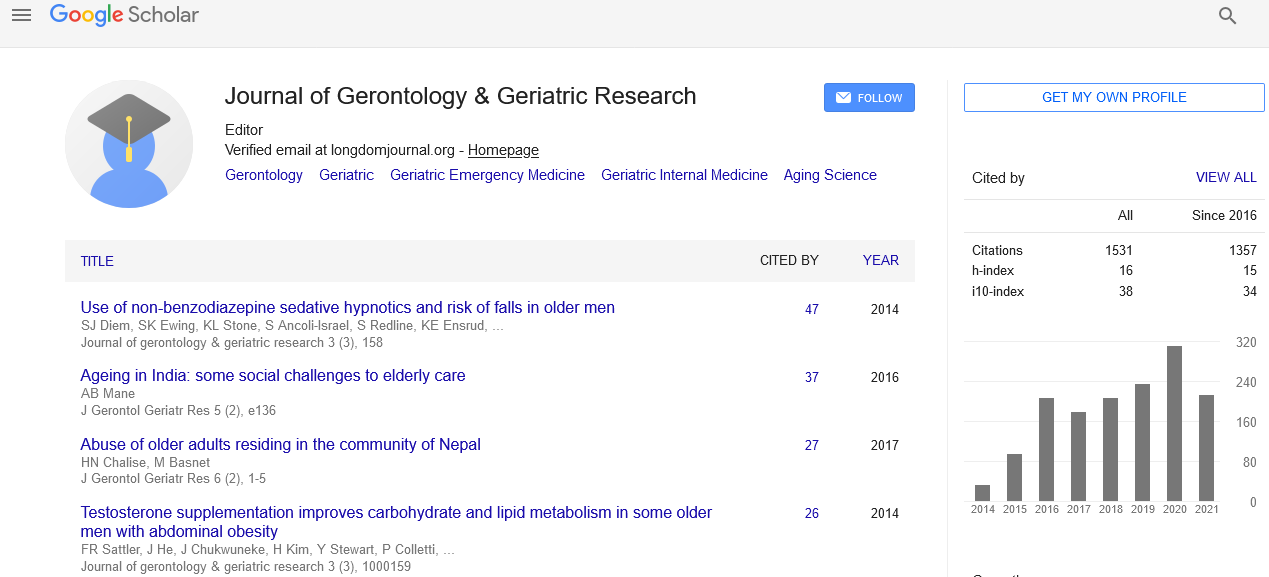PMC/PubMed Indexed Articles
Indexed In
- Open J Gate
- Genamics JournalSeek
- SafetyLit
- RefSeek
- Hamdard University
- EBSCO A-Z
- OCLC- WorldCat
- Publons
- Geneva Foundation for Medical Education and Research
- Euro Pub
- Google Scholar
Useful Links
Share This Page
Journal Flyer

Open Access Journals
- Agri and Aquaculture
- Biochemistry
- Bioinformatics & Systems Biology
- Business & Management
- Chemistry
- Clinical Sciences
- Engineering
- Food & Nutrition
- General Science
- Genetics & Molecular Biology
- Immunology & Microbiology
- Medical Sciences
- Neuroscience & Psychology
- Nursing & Health Care
- Pharmaceutical Sciences
Editorial - (2021) Volume 10, Issue 9
Anxiety and Depression in Late Life
Geeta Chacko*Received: 20-Sep-2021 Published: 30-Sep-2021, DOI: 10.35248/2167-7182.20.10.571
Editorial
In later life, depression and anxiety are very common. Indeed, statistics imply that depression affects about 25% of the elderly, whereas anxiety disorders affect 10 to 20% of the population. Furthermore, there is a significant comorbidity between depression and anxiety in later age, which is linked to a poor clinical outcome. Many older persons have been exposed to childhood maltreatment or neglect, and studies have consistently shown that childhood adversity increases susceptibility to depression and anxiety in early adulthood. Childhood trauma was projected to be prevalent in 13.5% of American adults over 55 years old for verbal abuse, 9.6% for physical abuse, and 9.3% for sexual assault. However, there is little research in this field in older adults, and little is known about the mechanisms behind the link between childhood trauma and anxiety and depression later in life.
For ageing cultures, multi-morbidity and depression are two major challenges. Multi-morbidity, which is defined as the co-occurrence of numerous chronic conditions in the same person, affects the majority of older people, severely limiting their functional status, quality of life, and contributing to mortality. Depression, on the other hand, is a prevalent mental health illness that manifests itself in a variety of ways and has a significant detrimental influence on the lives of older people and their caretakers. Multi-morbidity and depression frequently coexist, according to epidemiological research, and their presence appears to induce a cascade of disruptions that culminates in an even larger strain in terms of disability and mortality. As a result, both disorders are high-priority research and clinical goals in the field of ageing.
The ageing process, according to geroscience, is characterised by the disruption of various biological processes operating at the cellular and biomolecular levels, including mitochondrial failure, oxidative stress, telomere shortening, and cellular senescence. These proaging factors have been related to faster disease development in the face of depleted compensatory mechanisms, suggesting that multi-morbidity may be seen as one of the phenotypic markers of biological ageing. Similarly, studies using several biological age markers imply that depression could be one of the manifestations of brain degeneration. Indeed, depression in later life has been identified as the most common clinical manifestation of neural network dysfunctions involved in mood regulation. As a result, late-life multi-morbidity and depression may be considered as connected phenomena that are caused by the accumulation of various disruptions caused by rapid ageing and exhausted compensating systems.
Risk factors for late-life depression and multi-morbidity are multifaceted, according to epidemiological research, and include both individual and environmental factors. A number of factors, including inflammation, sedentary behaviour, and social deprivation, have all been linked to the onset of both diseases, possibly magnifying the consequences of accelerated ageing. Individual and environmental factors, which are grouped into broader domains that include biological, psychosocial, and carerelated factors over the course of a person's life, may be important for regulating the bidirectional feedback loops between multimorbidity and depression in the context of advancing disturbances associated with ageing.
Citation: Chacko G (2021) Anxiety and Depression in Late Life. J Gerontol Geriatr Res. 10: 571
Copyright: © 2021 Chacko G. This is an open-access article distributed under the terms of the Creative Commons Attribution License, which permits unrestricted use, distribution, and reproduction in any medium, provided the original author and source are credited.


